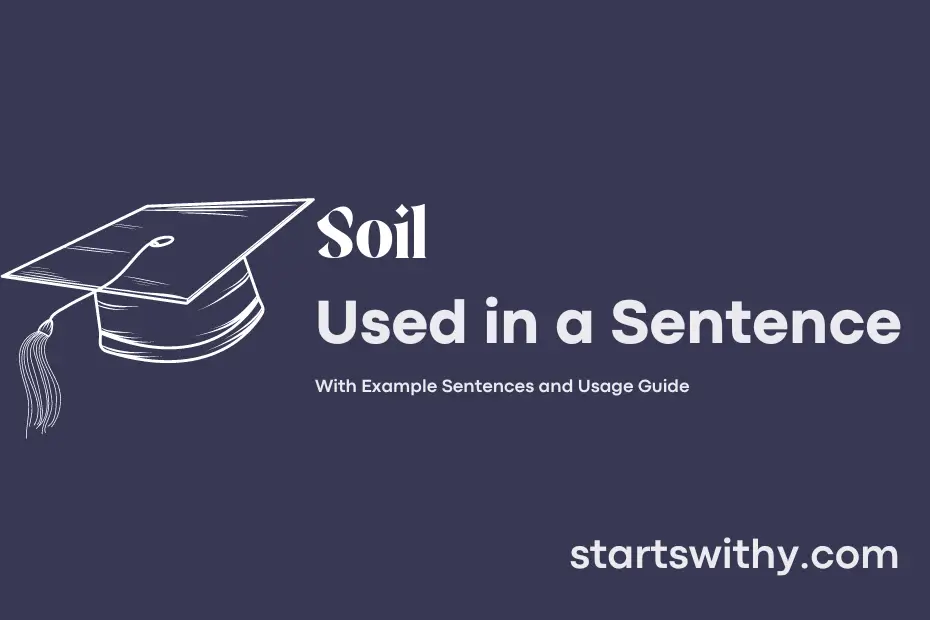Are you curious about the intricate world beneath our feet? Soil, the foundation of terrestrial life, is a complex mix of minerals, organic matter, water, air, and living organisms. It serves as a crucial medium for plant growth and supports the vast web of life on Earth.
Understanding the properties and composition of soil is essential for various fields such as agriculture, ecology, and environmental science. By studying soil, scientists can unlock valuable insights into nutrient cycling, water retention, and the impacts of human activities on the environment. Let’s delve deeper into the fascinating realm of soil and explore its critical role in sustaining life on our planet.
7 Examples Of Soil Used In a Sentence For Kids
- Soil is where plants grow.
- We can dig and play in the soil.
- Soil comes in different colors like brown, black, and red.
- Worms and insects live in the soil.
- Plants need nutrients from the soil to grow.
- We can make mud pies with the soil.
- It is important to take care of the soil for our plants to grow well.
14 Sentences with Soil Examples
- Soil erosion can lead to decreased agricultural productivity in farming communities.
- Understanding the composition of soil is crucial for successful cultivation of crops.
- Environmental science students often conduct experiments to analyze the health of soil.
- Learning about the various types of soil is essential for aspiring geologists.
- Civil engineering students study the mechanics of soil to design stable structures.
- Soil conservation techniques play a vital role in sustainable agriculture practices.
- Chemistry students investigate the presence of different nutrients in the soil.
- Botany majors study how different plants interact with soil in their natural habitat.
- Biotechnology students focus on developing solutions for improving soil fertility.
- Agricultural engineering students design equipment to optimize soil preparation for planting.
- Microbiology students analyze the microbial populations present in soil samples.
- Soil pollution is a significant concern that environmental studies students address through research.
- Urban planning students consider the quality of soil when designing green spaces in cities.
- Water resource management students study how soil characteristics affect water absorption and runoff.
How To Use Soil in Sentences?
To use the word Soil properly in a sentence, first identify when soil refers to the earth in which plants grow rather than dirt. For example, “The farmers were busy tilling the soil in preparation for planting.” In this case, soil refers to the nutrient-rich material that supports plant life.
Next, consider soil in a figurative sense, such as when soil is used to denote something that tarnishes or ruins. For instance, “The scandal threatened to soil the reputation of the company.” Here, soil is used metaphorically to imply damage or disgrace.
Remember that soil is both a noun and a verb. As a noun, it refers to the physical earth or a dirty substance. As a verb, it means to make dirty or tarnish. Ensure you are using the correct form of soil based on the context of your sentence.
Lastly, pay attention to the context in which you are using soil to ensure it fits naturally within your sentence structure. Consider the tone and style of your writing to determine the best way to incorporate soil effectively.
By following these guidelines and practicing with various sentences, you will become more comfortable and confident in incorporating soil appropriately in your writing.
Conclusion
In conclusion, it is evident from the examples provided that sentences involving the keyword “soil” mainly revolve around its importance, composition, and various characteristics. These sentences highlight how soil plays a vital role in supporting plant growth, influencing agricultural productivity, and indicating environmental health. Additionally, they emphasize the significance of maintaining healthy soil through proper management practices to ensure sustainability and food security.
Overall, the sentences featuring the keyword “soil” underscore the crucial role this natural resource plays in the ecosystem and the need to protect and conserve it for future generations. Understanding the complexities of soil composition and its impact on the environment is essential for making informed decisions and promoting sustainable agricultural practices.



